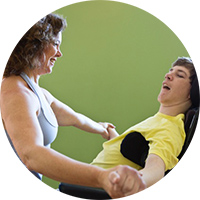Yoga Truly is for Every Body
Published June 28, 2016

I’ll often bring my yoga mat to the hospital when my son, Sean, is admitted. And unfortunately, he is admitted often for care due to his severe cerebral palsy. During a stay for pneumonia at Children’s Hospital of Philadelphia in 2013, I realized that Sean, too, could benefit from the transformative power of yoga.
Sean had been struggling to breathe without the support of supplemental oxygen. It had been a long day and there was never an opportunity to step away for something to eat, let alone unroll my mat. As the last doctor weighed in on Sean’s care and headed out for the evening, I laid my mat out next to Sean’s hospital bed, queued up some soothing music and began my practice. Within minutes, Sean’s nurse came into the room, asking what we were doing. She had seen Sean’s oxygen saturation increase and his elevated heart rate lower on the monitors outside his room. When she walked in, she noticed Sean’s color had improved and his breathing was less labored. Sean had found yoga.
Soon after Sean’s hospitalization, I opened Yoga Home, a community yoga studio in Conshohocken, with my dear friend and teacher, Maura Manzo. Our vision was to create a safe and inclusive space for all, to integrate mind-body approaches and wellness practices into mainstream daily life and to do our part in creating a world that acknowledges the sacredness of all things.
I was thrilled that Yoga Alliance recognized our efforts to bring yoga to diverse populations through our International Day of Yoga event, Yoga for Special Populations on June 25, 2016.
Yoga for Special Populations grew out of my experience with Sean (who is a regular at Yoga Home). I now offer Adaptive Yoga classes at Yoga Home, which has participants with cerebral palsy, multiple sclerosis and Down Syndrome.
There are so many who may not feel that yoga is possible for them due to disability, age or body size. We’re firmly committed to helping everyone find access to yoga and supporting them on their journey. The basic principles of yoga – grounding, expansion, balance and rhythm, can be applied to any body. I studied Adaptive Yoga with Matthew Sanford, who says, “the principles of yoga do not discriminate, yoga poses do.”
Adaptive Yoga is just that—yoga. I’m not ‘stretching’ Sean; rather, I’m encouraging Sean to develop his mind-body connection to become more fully integrated to his body. He is in control of the experience; I’m simply there to facilitate the process.
For me personally, yoga has long been a tool to manage the intense and often overwhelming demands of caregiving—a way to create the space to process and treat myself with compassion. It never occurred to me that Sean, too, needed yoga…until he showed me.
Sean wasn’t twisting his body into fancy poses. His high spasticity and limited range of motion make that impossible. He wasn’t standing on one leg in a balance pose. He lacks the ability to stand unsupported and uses a wheelchair for mobility. And he wasn’t chanting Sanskrit or voicing his intention, as he lacks language and the ability to speak. He was simply breathing, relaxing into his body and coming into community with my breath. This is yoga.
Based on my experience, I recommend any teacher interested in learning more about adaptive yoga do the following:
- Trust in yourself. If you are a yoga teacher who is passionate about helping individuals with disabilities discover the mind-body-spirit connection, you’re off to a great start!
- Invest in training. Depending on which population speaks to you, find a training that supports your vision as a teacher.
- Invest in props. Students in Adaptive Yoga often have a great deal of asymmetry in their bodies. Blocks, blankets, bolsters and straps may be needed to modify postures safely and appropriately. You’ll be amazed how quickly you incorporate greater use of props in all of your classes.
- Connect with other teachers who share your passion. Know that you will likely feel overwhelmed and that finding support from others – whether it’s how to modify a specific asana or handle a specific client request – will help you stay grounded and best serve your clients.
About Kerri
Kerri, RYT 200, believes the heart of a yoga practice is the art of acceptance, of ourselves and others. It’s her belief that yoga is for everyone – all ages, all abilities, all body shapes and sizes – that sparked her to partner with Maura Manzo, E-RYT 200, to open Yoga Home. She is passionate about bringing Adaptive Yoga to the Philadelphia region, and credits her son, Sean, who has severe cerebral palsy, with being her inspiration.
Kerri is also Co-Executive Producer of On the Other Side of the Fence, the Emmy and New York International Film Festival winning documentary recognized by the United Nations that encourages a culture of diversity and acceptance. She was also one of the recipients of Yoga Alliance’s 2016 International Day of Yoga grants for her event, Yoga for Special Populations.